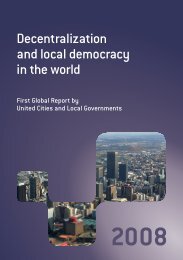Making Cities Resilient Report 2012
Making Cities Resilient Report 2012
Making Cities Resilient Report 2012
You also want an ePaper? Increase the reach of your titles
YUMPU automatically turns print PDFs into web optimized ePapers that Google loves.
Box 5.2 :<br />
Quirihue : PLADECO reflects community engagement<br />
Quirihue is a member of the Association of nine Municipalities of the Valle de Itata region of Chile. The<br />
following example offers insight into how local governments collectively define priorities. Quirihue (and<br />
the region of Valle de Itata) was close to the epicentre of the major 8.8 magnitude earthquake on 27<br />
February 2010 18 . Subsequently, UN-Habitat, the Association Territoires Solidaires and UNISDR helped to<br />
organize training on local-level development and the Ten Essentials for making cities resilient. Through<br />
engagement in the Campaign, the municipality began including measures to deal with disasters more<br />
effectively and has integrated disaster risk reduction and resilience into their Community Development<br />
Plan (PLADECO), developed for the period <strong>2012</strong>-2015, guided by principles of the Ten Essentials.<br />
PLADECO is the formal instrument for development planning at the local level in Chile. It guides municipal<br />
action on addressing community needs and provides guidance on investments for other government<br />
institutions and private actors. The process by which Quirihue developed this plan points to how priorities,<br />
and by extension, indicators, could be collectively developed. During preparation of the plan, the city<br />
undertook a qualitative diagnosis with organisations and local actors. The municipality used many vehicles<br />
to increase community engagement (advertising via blogs and websites; radio ads; flyers handed out on<br />
the street, etc.). This led to a roundtable discussion in early <strong>2012</strong> on the community’s weaknesses and<br />
strengths, including managing risk. Participants (91 people) were grouped according to their profile (i.e.,<br />
urban social organisations, rural social organisation, youth, traders and entrepreneurs, representatives of<br />
institutions and public services, etc.). Facilitators guided discussions around questions including: What are<br />
the community’s main problems What are the main problems in the neighbourhood or sector where you<br />
live What are the community’s strengths What opportunities do you see for community development<br />
What are some potential solutions to the problems identified This consultation helped identify planning<br />
priorities, including those for risk reduction.<br />
One of PLADECO’s strategic objectives is to reduce disaster risk in Quirihue to achieve sustainable local<br />
human development, through comprehensive risk management, led by the municipality. In this regard,<br />
the municiaplity also developed a Disaster Risk Reduction Plan, which designates financial responsibilities<br />
(see summary in Box 5.2). These activities set forth in the plan, could translate into quantitative indicators<br />
of resilience and an analysis of the achievement of goals would serve as a barometer of the city’s resilience.<br />
18. The quake impacted six of the country’s 13 regions, where 80 per cent of the population lives. The majority of the country’s hospital facilities<br />
are located in these regions, with 77per cent (20,950) of hospital beds. Two months after the event, authorities estimate that the earthquake<br />
affected 2 million people; 370,000 homes, 73 hospitals, and 4,012 schools (nearly half the schools in the affected area) were damaged or<br />
completely destroyed. The cost of losses and damage is estimated to reach US$ 30 billion, equivalent to 17 per cent of the country’s gross<br />
domestic product. (Source: PAHO/WHO).<br />
70 | <strong>Making</strong> <strong>Cities</strong> <strong>Resilient</strong> <strong>Report</strong> <strong>2012</strong>

















